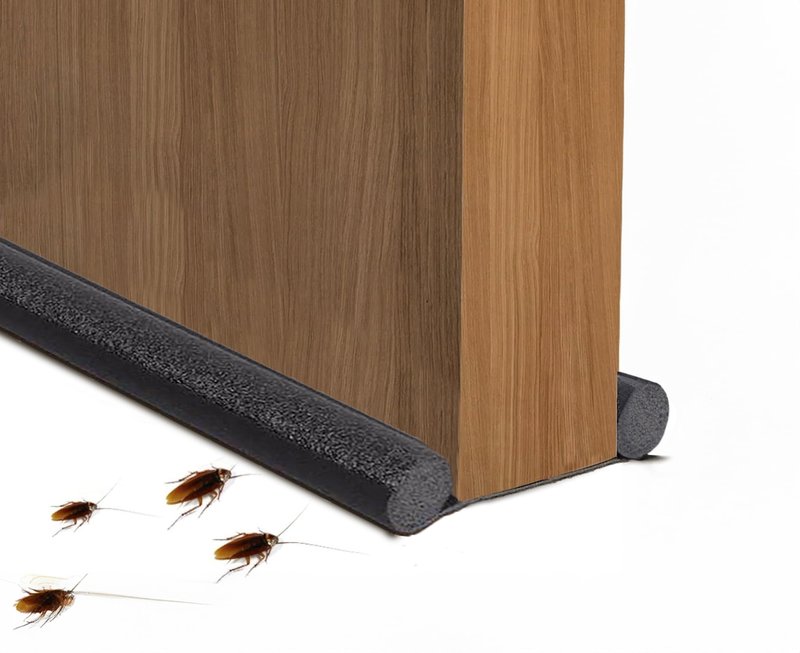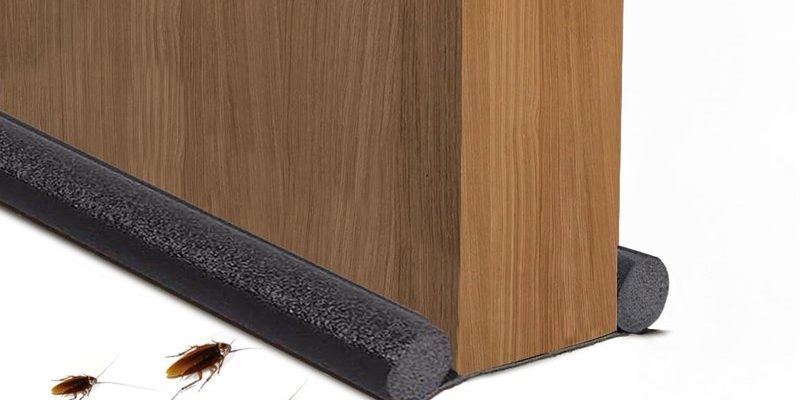
Here’s the thing: *door sweeps* are one of the simplest—and most effective—ways to block those gaps. Picture a door sweep like a sturdy, flexible brush or strip that hugs the bottom of your door, sealing out drafts and uninvited guests alike. While there are countless types and brands out there (from the ever-popular Suptikes Under Door Draft Stopper to weather-sealed options from M-D Building Products), what matters most is finding the right sweep for your door and your bug-battling needs.
Why Insects Love Gaps Under Doors
Bugs don’t need much to slip inside your home. Even a gap as small as a pencil’s thickness is enough for ants, spiders, or centipedes to sneak through. Most exterior doors don’t sit flush against the threshold. Over time, doors can warp, floors can settle, and suddenly there’s just enough space for critters to crawl in.
Let me explain it another way: If your door was a dam, that little gap would be a leak. And bugs are like water—they find every possible crack. Nighttime light, warmth, or just the promise of crumbs can pull them in. A door sweep acts like a seal, making that bottom edge less inviting and way harder to cross. So, if you’ve tried sprays or traps but bugs keep returning, the problem might start right at your threshold.
Types of Door Sweeps for Bug Prevention
Not all door sweeps are built the same—and the right choice depends on your door type and bug problems. Here are the most common styles you’ll come across:
- Brush sweeps: These have rows of stiff bristles that flex to fit uneven floors. They’re good for rough surfaces but might let in tiny insects if the bristles aren’t dense enough.
- Rubber or silicone sweeps: These create a solid, wipe-like seal against the floor. They block air, dust, and, yes, most crawling bugs. The Suptikes Under Door Draft Stopper, for example, uses thick silicone fins that work on wood, tile, and even carpet.
- Automatic door bottoms: A bit fancier, these drop a seal down only when the door is closed. They’re pricier but offer a snug fit—great if you want minimal fuss and maximum bug defense.
It can feel a little overwhelming at first—do you need stick-on, screw-in, or slide-on? For a total beginner, a self-adhesive strip (like Suptikes) is a breeze. You just measure, cut, peel, and stick. If you want a more permanent fix, metal sweeps with screw mounts are sturdy but take a bit more handiwork.
How To Install a Door Sweep: Step-by-Step
You might be wondering, “Is installing a door sweep a DIY job, or do I need a pro?” Honestly, most people can do it themselves—even if your toolbox is just a pair of scissors and a screwdriver. Here’s a simple walk-through:
- Clean the area: Wipe down the bottom edge of the door. No one wants to stick new hardware onto dust and grime.
- Measure the door width: Use a tape measure to get the exact width of your door. Cut your sweep to fit if it’s too long.
- Position the sweep: For adhesive types, line up the sweep so it just touches the floor, not dragging—otherwise, the door will be hard to open.
- Attach the sweep: Peel off the backing and press firmly for adhesive, or use the screws for metal sweeps. Most brands include instructions, but the process is about as tough as hanging a picture frame.
A quick heads-up: If your floor is uneven or heavily textured, flexible silicone sweeps usually seal better than rigid strips. If you ever swap out the sweep, removing adhesive residue is just a matter of a gentle scrape and a bit of cleaner.
Top Door Sweeps for Insect Prevention in 2024
There’s no shortage of options, but a few products rise above the rest in real-world testing. Here’s a quick summary in a handy table:
| Brand/Model | Material | Features | Best For |
| Suptikes Under Door Draft Stopper | Silicone | Self-adhesive, easy install, flexible fins | Quick DIY, uneven floors |
| M-D Building Products 68247 | Aluminum & vinyl | Screw-on, durable, weatherproof | Long-term, heavy use |
| Holikme Twin Door Draft Stopper | Foam & fabric | Slide-on, double-sided, reusable | Interior use, rentals |
| MAXTID Door Seal Strip | Rubber | Adhesive, budget-friendly, water-resistant | Budget pick, bathrooms |
Each type has its strengths. If you want zero tools, Suptikes makes it easy. If you hate replacing things every year, the M-D Building Products sweep is built to last. For renters or apartments, the slide-on styles won’t leave marks. Double-sided options add insulation but aren’t always as tight against the bugs.
What Makes a Door Sweep “Best” for Bugs?
A sweep’s real job is to create an *unbroken* barrier. Here’s what sets the best door sweeps for insect prevention apart:
- Tight, flexible seal: Insects are persistent. If there’s a gap, they’ll find it. The best sweeps mold to uneven thresholds—no daylight peeking through.
- Durable material: Sun, rain, and regular foot traffic can break down cheap materials fast. Silicone and rubber hold up longer than foam or felt.
- Easy installation: No one wants a two-hour project just to keep out bugs. Self-adhesive sweeps are the easiest, but even screw-on models should come with pre-drilled holes and clear instructions.
Sometimes, you’ll see fancy “soundproof” or “thermal” sweeps. Those features are nice, but if *insect prevention* is your main goal, prioritize fit and flexibility over marketing jargon. The tighter the seal, the fewer bugs you’ll see.
Common Problems and Troubleshooting Tips
Even the best door sweep can fall short if it’s not the right type—or if it’s installed just a tad off. Here are a few issues that crop up and how to fix them:
Door suddenly hard to open? The sweep might be pressing too tightly against the floor. Trim it or adjust the placement.
- Still seeing bugs? Check the sweep’s edges. Sometimes, tiny gaps on the corners or uneven surfaces break the seal. Try a wider or thicker sweep, or add a second strip for stubborn spots.
- Adhesive peeling off? Clean the door with rubbing alcohol before installing. In humid spots, screw-on models might last longer.
- Drafts or noise leaking through? You might need a sweep with denser material, or consider pairing it with a weatherstripping kit.
Remember, no sweep lasts forever. If it’s cracked, flattened, or gnawed by a determined pet, it’s time for a swap. Luckily, replacement isn’t much harder than your first install.
Should You Combine Door Sweeps With Other Bug Barriers?
If you battle stubborn swarms—think summer ants or persistent spiders—you might need a multi-layered approach. Sweeps block the bottom, but insects are clever. Pairing your sweep with these can help:
- Weatherstripping for the sides and top: Many kits come with adhesive foam or rubber strips. These fill in the rest of the door frame.
- Threshold plates: Metal or plastic strips that sit on the floor for an even tighter seal.
- Screen doors: If you like a breeze but hate bugs, pairing a tight sweep with a screen door is double insurance.
Honestly, most homes get by with a good sweep alone. But if you live somewhere humid, buggy, or with older doors, a “belt and suspenders” approach keeps even the smallest pests outside where they belong.
When to Replace Your Door Sweep
Even the best door sweep for preventing insects from entering won’t last forever. Signs it’s time for a replacement include:
- The sweep is torn, flat, or no longer springy.
- You can see daylight under the door or feel a draft.
- Bugs start appearing again in places they’d stopped.
Most adhesive sweeps last about 1–3 years, depending on weather and foot traffic. Screw-on versions can last much longer, but it never hurts to check your sweep every season—especially after extreme weather or a deep clean.
A well-maintained door sweep keeps working quietly in the background, blocking bugs so you don’t have to think about it every day. That’s real peace of mind.
In the end, the *best door sweep for preventing insects from entering* is the one that fits your door, your lifestyle, and keeps those tiny invaders right where they belong—outside. Whether you choose an easy-to-install adhesive strip or invest in a long-term metal sweep, a little effort now pays off in a lot fewer creepy crawlers later. Keep an eye on your sweep, check it every once in a while, and you’ll enjoy a bug-free zone at home—no special sprays or traps required.
